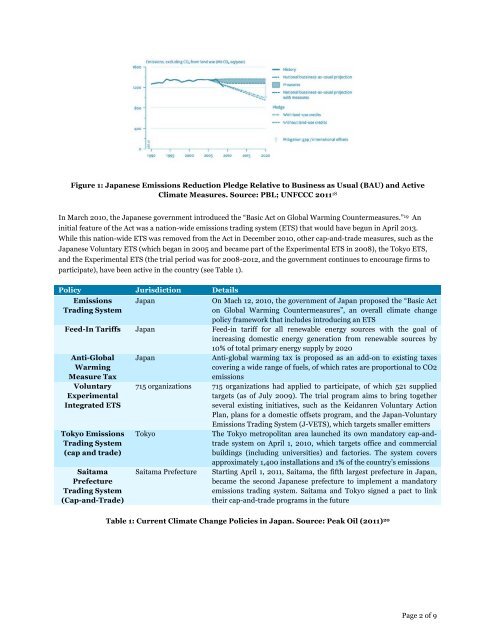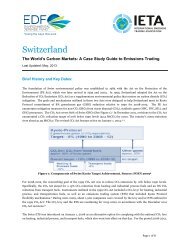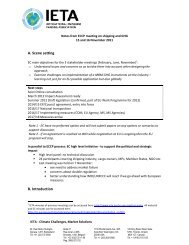Japan / The World's Carbon Markets - IETA
Japan / The World's Carbon Markets - IETA
Japan / The World's Carbon Markets - IETA
You also want an ePaper? Increase the reach of your titles
YUMPU automatically turns print PDFs into web optimized ePapers that Google loves.
Figure 1: <strong>Japan</strong>ese Emissions Reduction Pledge Relative to Business as Usual (BAU) and Active<br />
Climate Measures. Source: PBL; UNFCCC 2011 18<br />
In March 2010, the <strong>Japan</strong>ese government introduced the “Basic Act on Global Warming Countermeasures.” 19 An<br />
initial feature of the Act was a nation-wide emissions trading system (ETS) that would have begun in April 2013.<br />
While this nation-wide ETS was removed from the Act in December 2010, other cap-and-trade measures, such as the<br />
<strong>Japan</strong>ese Voluntary ETS (which began in 2005 and became part of the Experimental ETS in 2008), the Tokyo ETS,<br />
and the Experimental ETS (the trial period was for 2008-2012, and the government continues to encourage firms to<br />
participate), have been active in the country (see Table 1).<br />
Policy Jurisdiction Details<br />
Emissions<br />
Trading System<br />
<strong>Japan</strong><br />
On Mach 12, 2010, the government of <strong>Japan</strong> proposed the “Basic Act<br />
on Global Warming Countermeasures”, an overall climate change<br />
policy framework that includes introducing an ETS<br />
Feed-In Tariffs <strong>Japan</strong> Feed-in tariff for all renewable energy sources with the goal of<br />
increasing domestic energy generation from renewable sources by<br />
10% of total primary energy supply by 2020<br />
Anti-Global<br />
Warming<br />
Measure Tax<br />
Voluntary<br />
Experimental<br />
Integrated ETS<br />
Tokyo Emissions<br />
Trading System<br />
(cap and trade)<br />
Saitama<br />
Prefecture<br />
Trading System<br />
(Cap-and-Trade)<br />
<strong>Japan</strong><br />
Anti-global warming tax is proposed as an add-on to existing taxes<br />
covering a wide range of fuels, of which rates are proportional to CO2<br />
emissions<br />
715 organizations 715 organizations had applied to participate, of which 521 supplied<br />
targets (as of July 2009). <strong>The</strong> trial program aims to bring together<br />
several existing initiatives, such as the Keidanren Voluntary Action<br />
Plan, plans for a domestic offsets program, and the <strong>Japan</strong>-Voluntary<br />
Emissions Trading System (J-VETS), which targets smaller emitters<br />
Tokyo<br />
<strong>The</strong> Tokyo metropolitan area launched its own mandatory cap-andtrade<br />
system on April 1, 2010, which targets office and commercial<br />
buildings (including universities) and factories. <strong>The</strong> system covers<br />
approximately 1,400 installations and 1% of the country’s emissions<br />
Saitama Prefecture Starting April 1, 2011, Saitama, the fifth largest prefecture in <strong>Japan</strong>,<br />
became the second <strong>Japan</strong>ese prefecture to implement a mandatory<br />
emissions trading system. Saitama and Tokyo signed a pact to link<br />
their cap-and-trade programs in the future<br />
Table 1: Current Climate Change Policies in <strong>Japan</strong>. Source: Peak Oil (2011) 20<br />
Page 2 of 9










![South Korea [PDF] - International Emissions Trading Association](https://img.yumpu.com/38055599/1/190x245/south-korea-pdf-international-emissions-trading-association.jpg?quality=85)
